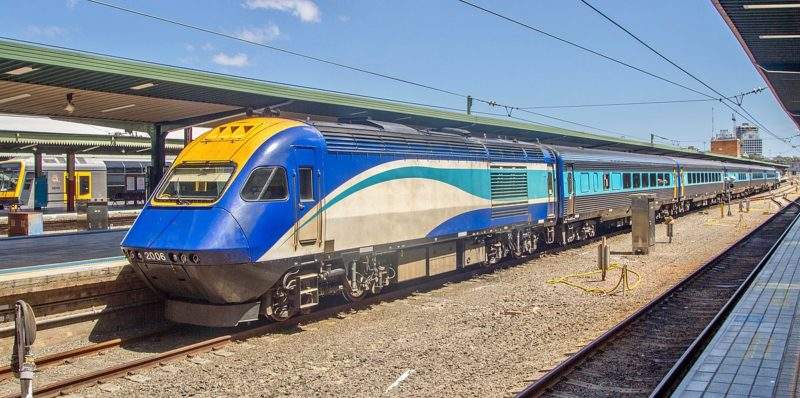
August 2018 marked the inauguration of the first Inland Rail Conference, held in Parkes, New South Wales, Australia. The event, organised by the Australian Logistics Council and the Australian Railway Association, marked a big step forward in identifying the opportunities and challenges around the Inland Rail project, a scheme that has been on the cards for decades and has only this year begun construction.
Inland Rail is essentially a high-capacity freight line, linking Melbourne to Brisbane. But the project also seeks to connect the cities, farms, and mines in-between to domestic and international markets. The volume of freight travelling along Australia’s eastern seaboard is projected to rise to eight billion tonnes by 2030, and with three quarters of freight being transported by road, that’s a lot of extra money spent on road infrastructure, fuel and environmental offsetting.
The first proposal of a freight corridor between Melbourne and Brisbane was in 1902, but it wasn’t until 2006 that the project as we know it today started to take shape, when the first reports of a possible route were finally completed. After a further decade of studies, endorsements and government pledges, in 2017 the Federal Government committed A$8.4bn in the Australian federal budget to build the line, on top of the $594bn already allocated to it.
The project is also being touted as a big deal for rural Australia, with Prime Minister Scott Morrison saying in May last year that every regional location along the Inland Rail route would be supported. But any project of this size brings with it controversy and disagreement – and Inland Rail is no different.
Funding and budgetary concerns
According to the Department of Infrastructure, Regional Development and Cities, Inland Rail will boost the country’s gross domestic product (GDP) by A$16bn over the next 50 years and as a result of taking freight traffic off the roads, will reduce carbon emissions by 750,000 tonnes.
But in April 2017, concerns were raised following a 2015 feasibility study that the project would not be possible without significant government subsidies in the first 50 years of operation.
“Inland Rail will require significant, if not total, funding by Australian governments as it will not generate the financial returns required to make the project attractive to the private sector without a significant risk transfer to the Commonwealth that would come at a cost to the taxpayer well beyond the government funding Inland Rail from its balance sheet,” the study reads.
These concerns were revisited earlier this year, as the Australian Rail Track Corporation (ARTC) in February declared that the project, despite being treated as an equity investment, was in fact unlikely to generate a commercial return. ARTC CEO and managing director John Fullerton was quoted as saying that from a commercial perspective, Inland Rail would not be able to recoup its construction costs.
Route controversies
Two studies – the North-South Rail Corridor Study in 2006 and the Inland Rail Alignment Study in 2010 – were undertaken to agree on the route alignment for the Inland Rail project. It was decided that the current interstate line between Melbourne, Victoria and Illabo, New South Wales would be used, with enhancements being made to the line where necessary so that it can accommodate double-stacked trains. A combination of new and upgraded tracks via Parkes, Moree, Toowoomba and Calvert would be laid, joining up to the current interstate line.
The 2010 study claimed that 70% of Inland Rail could use existing rail corridors and that by using this route, an overall journey time of less than 24 hours was possible.
But controversy sprung up in 2017 when it was discovered that the Inland Rail line would deviate slightly from the 2010 proposal and would be built across the Condamine floodplain in Queensland. In September last year, the Australian Broadcasting Corporation (ABC) quoted grain farmers in the area on the innate flood risk associated with the area, which could potentially put lives at risk, after flooding in 2010 resulted in flood waters several kilometres high.
Separately, the Narrabri and Barradine Local Aboriginal Land Councils (LALCs) stated that until the final route was announced, they were unaware that Inland Rail’s line would be constructed straight through the Pilliga Forest in New South Wales, a site of huge cultural significance for local Aboriginal peoples.
Benefitting local communities?
In June 2018, a new alignment for Inland Rail was proposed at a community meeting in Forest Hill, Victoria, a suburb of Melbourne. The newly proposed route would bypass the townships of Gatton, Forest Hill and Laidley, as community members raised concerns of disruption and safety issues related to allowing double-stacked freight trains to travel so close to small towns.
These concerns could be seen as counterintuitive to the potential benefits quoted that would allow farms, mines, towns and cities better access to domestic and international markets. If towns do not want the line to pass near them, they will not see Inland Rail as dramatic a benefit.
In fact, it has been reported that the construction of new track near rural towns would be rather tricky and that the preferred corridor for a large section of the track in Queensland had to be reduced from up to five kilometres in width to only 50 metres.
Much of the work in this area will be outsourced to the private sector and ARTC’s Inland Rail chief executive Richard Wankmuller said that a public-private partnership was chosen as the most efficient and innovative development route.
“It’s a complicated section with many pieces,” Wankmuller said. “The amount of earthworks that have to be moved, the bridges that have to be built, the grade separations, the tunnels – this is a complicated piece of work and we are hoping to attract some good ideas from the private sector and benefit from innovation.”



